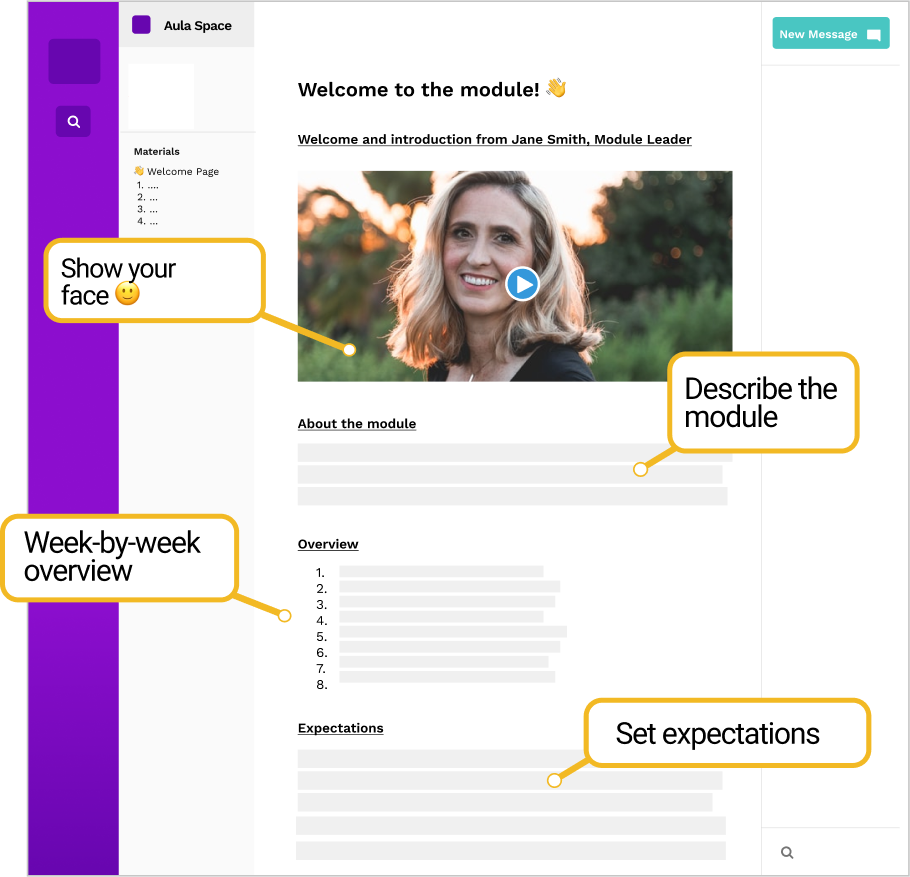Start your module (or your course) off on the right foot with a warm, welcoming and engaging Aula space. Students often have access to your Aula space before the module formally starts, so it’s the perfect place to set the right tone for the journey ahead.
Every student will also have access to a course community space in Aula and many of the tips from this article can be applied to making that a welcoming space too.
We’ll cover some of the most important items to include in an Aula welcome page:
- Introducing yourself (and your team)
- Outlining the module
- What you expect from your students
- What your students can expect from you
- Invite your students to introduce themselves
When you’ve got all that ready, create a page called “Welcome” and add it to the top of your Aula materials for the module. When you’re done, your learners will have a much better idea of who you are and what taking part in your module will mean for them:

Introducing yourself
Humans are social creatures, so introducing a human element to a digital space will help to make people feel more welcome. The quickest way to do this is to introduce yourself.
Video is a powerful tool for any teacher, and the best way to introduce yourself would be with a quick, 2-3 minute video (filmed on your smartphone or with any tool for creating video in our EdTech Ecosystem). No need for fancy lighting or video equipment – just grab a quiet space with good natural lighting and cover the basics:
- Your name
- Your role here in the Coventry University Group
- Why you’re excited about the module
It would also be good to cover all the rest of the topics in this article in a welcome video, but those items will also need to be in writing and are therefore optional in the video.
If you’d rather not create a video, a photo is still helpful here. You may be a bit camera shy, but it makes a huge difference for students to know who they’ll be working with in the weeks to come.
Why not include an audio welcome to go along with the photo if video isn’t your thing?
Outlining your module
Would you take on a long-distance walk without a map? Even with a guide, it would be possible but rather disconcerting. In the same way, you’ll put your learners at ease with a road map of what you expect to cover in your module week-by-week.
In an ideal world, you’d have a complete materials section set up for your students to explore at the start of your module, but with time constraints and the need to deliver up-to-date information, this isn’t always possible. Even if you haven’t prepared all your materials for the middle or end of your module yet, including a rough outline of what you’ll cover will help you and your learners feel prepared for the content to come.
If you need more help on populating your materials section, Aula have a great guide on how to add and nest pages in your space:
Ordering your materials section in Aula
What you expect from your students
Get everyone on the same page right from the start. It might sound a bit authoritarian but having clear expectations for students in writing before the module begins will help you manage expectations and interactions with your students further down the road.
A lot of the following items will be covered in the standard Aula template, but make sure your students know what you’re expecting in terms of:
- Attendance (synchronous lectures, seminars, labs, etc.)
- Participation (i.e. will there be elements of active learning and will this be assessed?)
- Workload (how much time should they expect to put in per week on your module?)
- Assessments (due dates, writing guidelines, rubrics, etc.)
- Communication (getting in touch if they’re having problems)
- Respect (student-to-student and student-to-teacher)
What students can expect from you
Your students will also want to know what they can expect from you. You might cover:
- Communication – how students should contact you or other educators and when they can expect a response (Aula? Email? Office hours?)
- Feedback (what kind of feedback can they expect on their assessments and when?)
Supporting students
This is also a good place to let students know that you’re there for them and can also help signpost them to appropriate services if they’re having educational or pastoral issues during their studies. To learn more about what support is available for students, check out some of the Student Services pages from the different parts of the Coventry University Group:
- Coventry University Student Support
- Coventry University London Student Services
- Coventry University Wrocław Student Support
- CU Coventry Student Support
- CU London Student Support
- CU Scarborough Student Support
Invite your students to introduce themselves
To make your Aula module space less of an information repository and more of a learning community, why not ask your students to introduce themselves?
This could be an embedded Padlet right there on your welcome page – here’s an example from the Padlet team based on introductions from participants at a baking conference:
https://padlet.com/embed/ob0qx8kz49yc
You could also invite them to comment on a welcome post or Padlet in the Aula community feed instead of hosting a conversation in your welcome page as it will be more likely to be seen.
To make your space even more welcoming learning community check out our article on Using the Aula feed which contains some helpful conversation starters.
